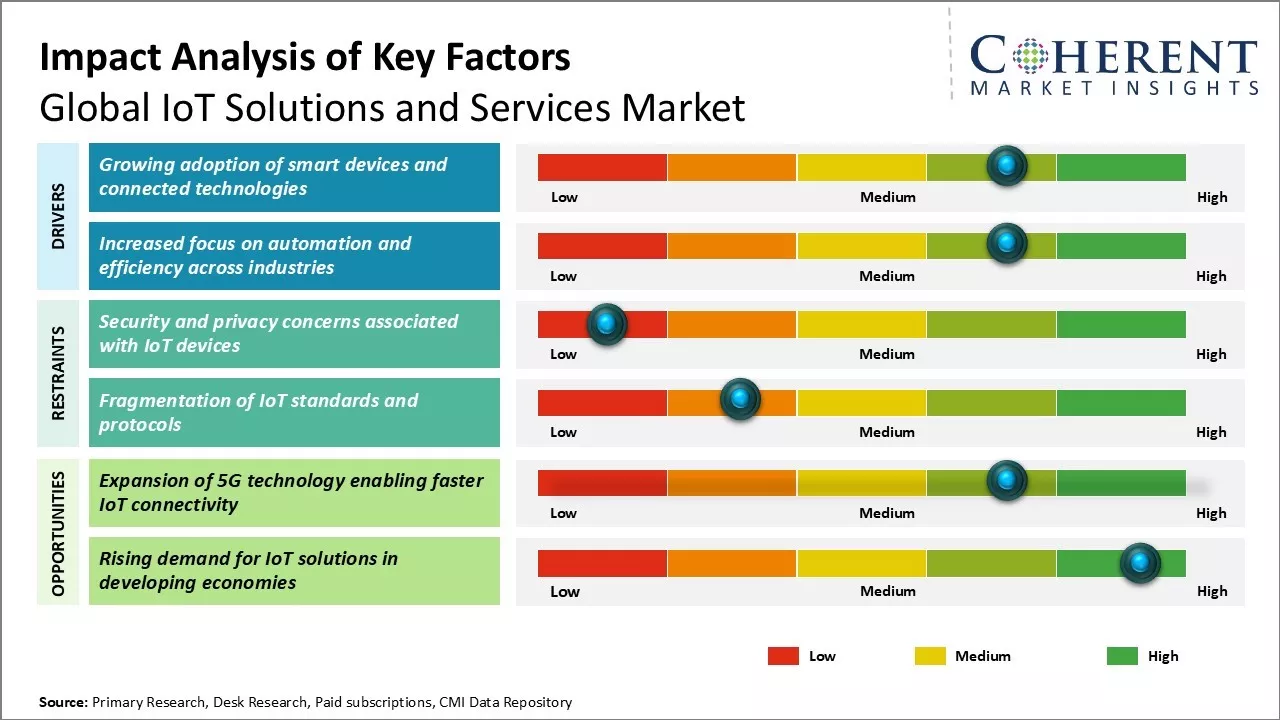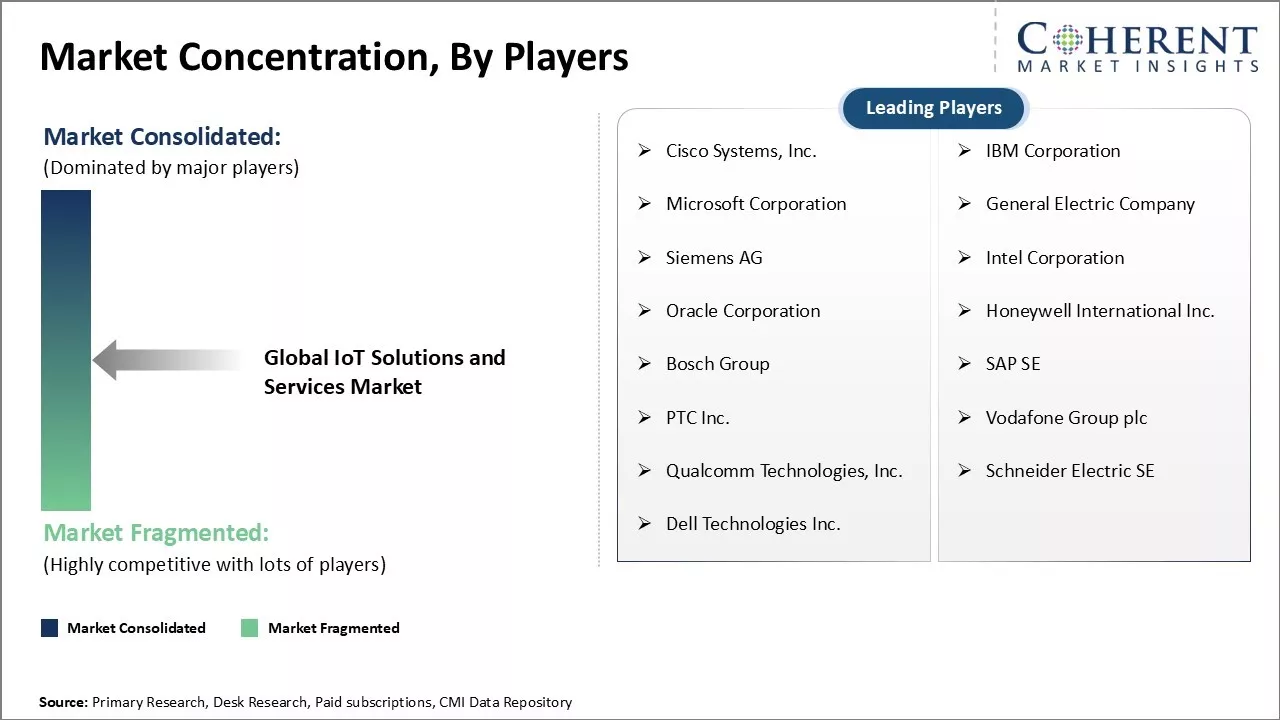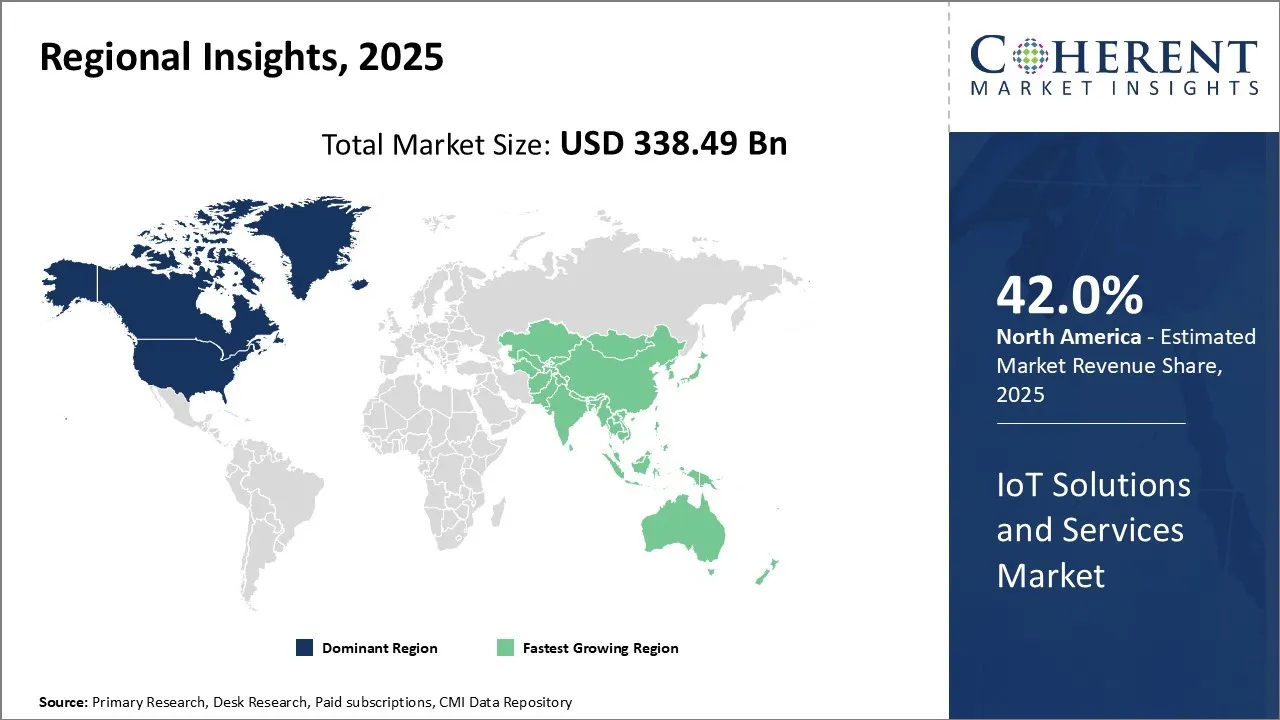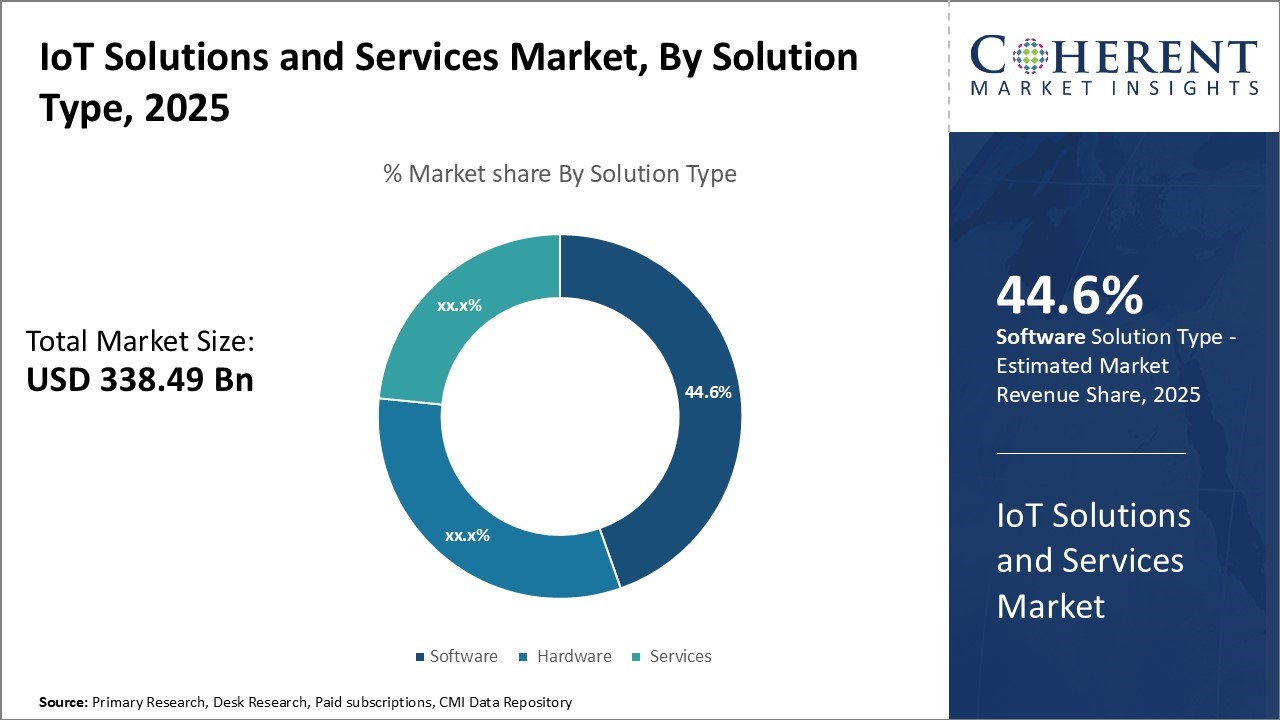IoT Solutions and Services Market Size and Trends Forecast – 2025 - 2032
The IoT solutions and services market is estimated to be valued at USD 338.49 Bn in 2025 and is expected to reach USD 1,091.77 Bn by 2032, exhibiting a compound annual growth rate (CAGR) of 18% from 2025 to 2032.

To learn more about this report, Download Free Sample
Key Takeaways of the IoT Solutions and Services Market
- The software segment is expected to represent 44.6% of the market share in 2025.
- The cloud-based segment is projected to hold 53.3% share of the market in 2025.
- The industrial IoT segment is anticipated to account for 32.1% of the market share in 2025.
- North America is expected to top the market with 42.0% share in 2025.
Market Overview
Growing adoption of advanced technologies such as AI, machine learning, and cloud computing can boost the demand for IoT solutions and services globally. Global IoT solutions and services market can witness significant growth during the forecast period due to rising deployment of IoT across various industry verticals such as manufacturing, healthcare, retail, transportation, and logistics.
However, global IoT solutions and services market growth can be hampered due to security and privacy concerns associated with various IoT devices. As IoT devices become more advanced and get connected to the internet, it raises several security and privacy issues.
Market Concentration and Competitive Landscape

To learn more about this report, Download Free Sample
Current Events and Its Impact
|
Current Events |
Description and its impact |
|
Geopolitical Tensions and Trade Policies |
|
|
Regulatory Shifts in Key Markets |
|
Uncover macros and micros vetted on 75+ parameters: Get instant access to report
Market Trends
Increasing Adoption of Smart Devices and Connected Technologies
The proliferation of smart consumer devices and industrial IoT systems is fundamentally transforming the IoT solutions and services market. Consumer adoption alone accounts for approximately 60% of all connected devices globally, with smartphones, smart home systems, and wearables driving this dominance. This surge creates the demand for complementary services like data analytics platforms and cybersecurity solutions.
IoT Solutions and Services Market Insights, by Solution Type: Dominance of Software Segment in Driving IoT Solutions and Services Adoption
In terms of solution type, the software segment is estimated to contribute the highest market share of 44.6% in 2025, owing to the pivotal role it plays in enabling the connectivity, operations, and data handling functions within IoT solutions.
As hardware devices proliferate at the edge with the rise of connected things, there has been huge need for high-level software platforms and programming tools that can integrate these disparate endpoints and extract meaningful insights. This presents a massive opportunity for software vendors to develop applications and operating systems tailored for specific industries and use cases.
IoT Solutions and Services Market Insights, by Deployment Mode: Cloud-Based Segment is Gravitating IoT Adoption by Offering Scalability and Economies of Scale
In terms of deployment mode, the cloud-based segment is estimated to contribute the highest market share of 53.3% in 2025, as IoT solutions leveraging cloud infrastructure have significant advantages over on-premises models in the forms of scalability, manageability, anywhere access, and low upfront costs.
As devices, endpoints, and data volumes expand exponentially, cloud deployment ensures IoT systems can grow seamlessly on-demand without extensive hardware procurement or management overhead. Cloud platforms provide automated tools to integrate, process, analyze and act on streaming IoT data with minimal effort.
Emerging Innovations in the IoT Solutions and Services Market
- The Integration of Edge Computing with IoT Networks
- Edge computing allows data processing closer to the source, minimizing latency, reducing bandwidth use, and enhancing real-time analytics capabilities. This is particularly critical for time-sensitive applications such as autonomous vehicles, industrial automation, and healthcare monitoring, where immediate data response can be a game-changer.
- The Proliferation of 5G Connectivity
- The proliferation of 5G connectivity, which offers markedly higher data speeds and improved network reliability compared to previous wireless technologies. The enhanced bandwidth and low latency provided by 5G enable IoT devices to communicate more efficiently and support more complex applications, such as augmented reality, smart cities infrastructure, and intelligent transportation systems.
Impacts of Artificial Intelligence (AI) in the IoT Solutions and Services Market
As AI becomes increasingly integrated into IoT solutions, the market is experiencing transformative growth and innovation across industries.
- Philips Healthcare introduced its IntelliVue Guardian Solution, which integrates AI with bedside IoT monitoring devices to predict patient deterioration in hospitals. The system continuously analyzes real-time patient vital signs, alerting medical staff before critical events occur. This AI-enhanced service has led to early interventions, better patient safety, and lower ICU admissions.
- Enel, a multinational energy company, integrates AI with IoT sensors across its distributed grid infrastructure. AI models analyze consumption patterns and environmental conditions, allowing automated adjustments to energy distribution and storage. This results in more reliable power delivery, cost savings, and reduced carbon emissions, demonstrating how AI-IoT convergence enhances functionality and value in complex systems.
Regional Insights

To learn more about this report, Download Free Sample
North America IoT Solutions and Services Market Analysis and Trends
North America has established itself as the dominant region in the global IoT solutions and services market with an estimated market share of 42.0% in 2025. With countries like the U.S. and Canada having a strong digital infrastructure backbone and early adoption of new technologies, many leading IoT players have set up their base in this region. Large number of innovative IoT startups are emerging from the Silicon Valley region, developing path breaking solutions across various sectors.
For instance, as per the National Cybersecurity Center of Excellence, it is estimated that there will be more than 75 billion IoT devices in use by 2025. With this massive market adoption of IoT, though, comes a trove of security concerns that necessitate attention and action.
Asia Pacific IoT Solutions and Services Market Analysis and Trends
Asia Pacific, especially countries like China, India, Japan and South Korea, is expected to be the fastest growing region. Factors such as rising internet penetration, growing middle class population and government initiatives towards smart cities boosts IoT adoption. China, with its strong manufacturing base, has emerged as a global manufacturing hub and companies are increasingly using IoT in connectivity along the supply chain.
For instance, as per Telenor IoT, in APAC, the combined growth of developed IoT regions (such as South Korea, Japan, Australia, and China) and the emerging IoT regions (such as India, Pakistan, Bangladesh, Indonesia, and Thailand) are pushing the 14.5 billion IoT devices in circulation to a forecasted 38.9 billion in 2030.
IoT Solutions and Services Market Outlook for Key Countries
U.S. IoT Solutions and Services Market Analysis and Trends
The U.S. remains a global leader in IoT adoption, driven by robust infrastructure and a culture of innovation. Government initiatives such as the National IoT Strategy promote the integration of IoT across various sectors, including healthcare, agriculture, and transportation. This support accelerates the development and deployment of IoT technologies, fostering a competitive market environment.
Germany IoT Solutions and Services Market Analysis and Trends
Germany's commitment to Industry 4.0 has been a catalyst for IoT adoption in the manufacturing sector. The integration of IoT technologies into production processes has led to increased efficiency, predictive maintenance, and real-time monitoring, making Germany a leader in industrial IoT solutions. This approach has set a benchmark for smart manufacturing globally.
India IoT Solutions and Services Market Analysis and Trends
India's IoT market is experiencing rapid growth, fueled by government initiatives like "Digital India" and the "Smart Cities Mission." These programs aim to enhance digital infrastructure and promote the adoption of IoT technologies in urban planning, agriculture, and healthcare. The government's focus on digital transformation is creating a conducive environment for IoT innovation and deployment across the country.
China IoT Solutions and Services Market Analysis and Trends
China's IoT market is propelled by strategic national initiatives like "Made in China 2025," which emphasize the development of smart manufacturing and AI-integrated systems. The government's focus on upgrading industrial capabilities and enhancing digital infrastructure has led to significant investments in IoT technologies, positioning China as a dominant player in the global IoT landscape.
Pricing Analysis of the IoT Solutions and Services Market
- North America & Europe: North America and Europe typically exhibit higher pricing for IoT solutions and services. Consulting fees in these regions generally range from USD 150 to USD 300 per hour, depending on the complexity of the engagement and the expertise required.
- APAC: USD 50 to USD 150/hr, project prices scaled accordingly.
- LATAM & MEA: USD 40 to USD 120/hr depending on local vendor and expertise.
Market Report Scope
IoT Solutions and Services Market Report Coverage
| Report Coverage | Details | ||
|---|---|---|---|
| Base Year: | 2024 | Market Size in 2025: | USD 338.49 Bn |
| Historical Data for: | 2020 To 2024 | Forecast Period: | 2025 To 2032 |
| Forecast Period 2025 to 2032 CAGR: | 18% | 2032 Value Projection: | USD 1,091.77 Bn |
| Geographies covered: |
|
||
| Segments covered: |
|
||
| Companies covered: |
Cisco Systems, Inc., IBM Corporation, Microsoft Corporation, General Electric Company, Siemens AG, Intel Corporation, Oracle Corporation, Honeywell International Inc., Bosch Group, SAP SE, PTC Inc., Vodafone Group plc, Qualcomm Technologies, Inc., Schneider Electric SE, and Dell Technologies Inc. |
||
| Growth Drivers: |
|
||
| Restraints & Challenges: |
|
||
Uncover macros and micros vetted on 75+ parameters: Get instant access to report
IoT Solutions and Services Industry News
- In February 2025, Cisco was named Industrial IoT Company of the Year 2025 in the IoT Breakthrough Awards Program. Since 2017, IoT breakthrough has made annual awards to industrial IoT companies and products based on quality, unique technology, and market leadership.
- In January 2025, GE Appliances, a Haier company, was named the “Smart Appliance Company of the Year” in the 2025 IoT Breakthrough Awards, recognizing standout companies and technologies in the Internet-of-Things (IoT) space.
- In May 2025, Siemens announced an expansion of its industrial AI offerings with advanced AI agents designed to work seamlessly across its established Industrial Copilot ecosystem. This new technology represents a fundamental shift from AI assistants that respond to queries towards truly autonomous agents that proactively execute entire processes without human intervention.
- In June 2025, Honeywell announced new digital technologies that leverage artificial intelligence and are designed to accelerate the industrial shift from automation to autonomy.
Analyst View
- The IoT solutions and services market is experiencing significant momentum, driven by rapid digital transformation across industries. Key drivers include the increasing adoption of smart devices and the growing emphasis on automation and real-time data analytics. Enterprises are leveraging IoT solutions to enhance operational efficiency, improve customer experiences, and enable predictive maintenance, thus reducing downtime and operational costs.
- Additionally, advancements in connectivity technologies such as 5G and edge computing are fueling broader IoT deployment by providing faster and more reliable data transmission.
- However, the market faces challenges related to data security and privacy concerns. The vast amount of data generated by IoT devices presents vulnerabilities that require robust security frameworks, which can slow adoption in some sectors. Regulatory compliance and standardization issues also act as barriers. Despite these restraints, there are ample opportunities in sectors like healthcare, manufacturing, and smart cities where IoT solutions can enable remote patient monitoring, smart factory automation, and intelligent infrastructure management respectively.
- Regionally, North America remains a dominant market due to well-established technology infrastructure and high adoption rates across various verticals. Meanwhile, the Asia-Pacific region is the fastest growing, fueled by rapid urbanization, government initiatives promoting smart city projects, and growing industrial IoT applications.
Market Segmentation
- By Solution Type Insights (Revenue, USD Billion, 2020 - 2032)
- Software
- Hardware
- Services
- By Deployment Mode Insights (Revenue, USD Billion, 2020 - 2032)
- Cloud-based
- On-premises
- Hybrid
- By Application Insights (Revenue, USD Billion, 2020 - 2032)
- Industrial IoT
- Smart Home
- Healthcare
- Transportation
- Agriculture
- Retail
- Others
- Regional Insights (Revenue, USD Tn, 2020 - 2032)
- North America
- U.S.
- Canada
- Latin America
- Brazil
- Argentina
- Mexico
- Rest of Latin America
- Europe
- Germany
- U.K.
- Spain
- France
- Italy
- Russia
- Rest of Europe
- Asia Pacific
- China
- India
- Japan
- Australia
- South Korea
- ASEAN
- Rest of Asia Pacific
- Middle East
- GCC Countries
- Israel
- Rest of Middle East
- Africa
- South Africa
- North Africa
- Central Africa
- Key Players Insights
- Cisco Systems, Inc.
- IBM Corporation
- Microsoft Corporation
- General Electric Company
- Siemens AG
- Intel Corporation
- Oracle Corporation
- Honeywell International Inc.
- Bosch Group
- SAP SE
- PTC Inc.
- Vodafone Group plc
- Qualcomm Technologies, Inc.
- Schneider Electric SE
- Dell Technologies Inc.
Sources
Primary Research Interviews
- IoT Solution Providers
- IoT Service Vendors
- Technology Integrators
- Industry Experts
- Others
Magazines
- IoT Now
- IoT World Today
- Connected World
- IoT Business News
- Others
Journals
- Journal of Internet of Things
- IEEE Internet of Things Journal
- Sensors Journal
- Others
Newspapers
- The Wall Street Journal
- Financial Times
- The Economic Times
- TechCrunch
- Others
Associations
- Industrial Internet Consortium
- IoT M2M Council
- Open Connectivity Foundation
- Internet of Things Consortium
- Others
Public Domain Sources
- Government Technology Reports
- World Economic Forum
- International Telecommunication Union (ITU)
- National Institute of Standards and Technology Publications
- Others
Proprietary Elements
- CMI Data Analytics Tool – IoT Solutions and Services Market
- CMI Existing Repository of Information for the Last 8 Years
*Definition: Global IoT solutions and services market provides companies with end-to-end IoT solutions and services to connect devices to cloud platforms and applications. It helps organizations develop IoT strategies, select the right connected devices and sensors, integrate IoT solutions with existing IT systems, ensure the security of connected devices and data, and manage and maintain IoT infrastructure. The services enable businesses to extract meaningful insights from IoT data to optimize operations, improve customer experiences and launch new data-driven products.
Share
Share
About Author
Ankur Rai is a Research Consultant with over 5 years of experience in handling consulting and syndicated reports across diverse sectors. He manages consulting and market research projects centered on go-to-market strategy, opportunity analysis, competitive landscape, and market size estimation and forecasting. He also advises clients on identifying and targeting absolute opportunities to penetrate untapped markets.
Missing comfort of reading report in your local language? Find your preferred language :
Transform your Strategy with Exclusive Trending Reports :
Frequently Asked Questions
EXISTING CLIENTELE
Joining thousands of companies around the world committed to making the Excellent Business Solutions.
View All Our Clients

